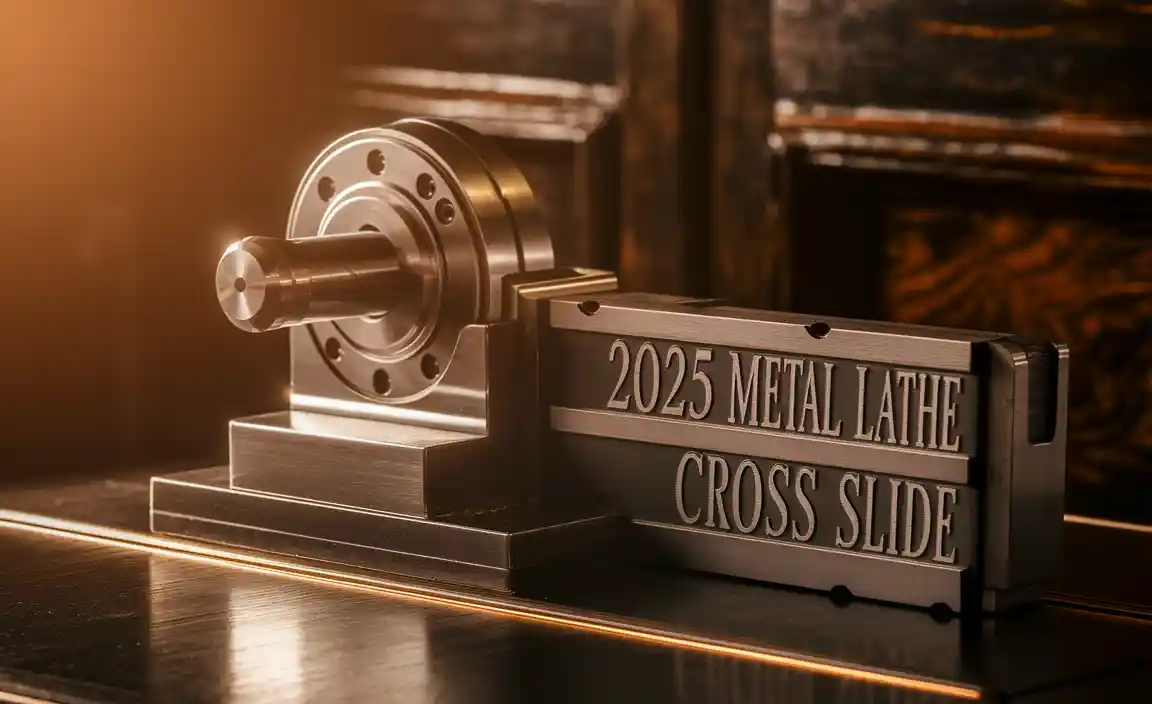Carbide End Mill 1/8 Inch: Achieve Proven Brass Precision
Unlock incredible detail and accuracy in your brass projects with a 1/8 inch carbide end mill. This guide shows beginners how to use this essential tool for clean cuts, minimizing wobble, and achieving professional results. Get ready to tap into precision machining for your creative endeavors.
Welcome to Lathe Hub! If you’ve ever tried to cut intricate shapes or detailed features into brass, you know it can be a bit tricky. Brass is soft enough to machine but can easily chip or leave a rough edge if you’re not using the right tools and techniques. For super fine work, especially on your milling machine, a small but mighty tool called the 1/8 inch carbide end mill is your best friend. It’s perfect for getting into tight spots and creating incredibly precise details. Don’t worry if you’re new to this; we’ll walk through everything step-by-step, making it easy and safe. By the end of this article, you’ll feel confident using your 1/8 inch carbide end mill to achieve stunning precision on your brass projects.
Why a 1/8 Inch Carbide End Mill for Brass?
When it comes to machining brass, precision is key. Brass is a fantastic material for creating detailed components, jewelry, or decorative items because it cuts relatively easily. However, its softness also means it can deform or produce a fuzzy edge if the wrong cutting tool is used. This is where the 1/8 inch carbide end mill shines.
Choosing the right end mill for brass involves understanding a few basics. Brass, being a softer metal, benefits from tools that can make clean, sharp cuts without tearing at the material. Carbide is an excellent choice for this because of its hardness and ability to hold a sharp edge longer than high-speed steel (HSS) tools. A 1/8 inch size is particularly useful for detailed work, allowing you to create fine lines, small pockets, and intricate carvings that larger end mills simply can’t manage.
The Advantages of Carbide
Carbide tools offer several benefits over traditional HSS for brass machining:
- Superior Hardness: Carbide retains its hardness at higher temperatures, meaning it stays sharp and effective even during high-speed machining.
- Longer Tool Life: Due to its hardness, carbide cutters last much longer than HSS, reducing the need for frequent replacements, which is cost-effective in the long run.
- Better Surface Finish: Carbide’s ability to maintain a sharp edge results in cleaner cuts and a smoother finish on the workpiece, often reducing the need for secondary finishing operations.
- Precision: For delicate operations on brass, a sharp carbide edge will produce crisp, accurate features.
Why 1/8 Inch?
The 1/8 inch diameter is invaluable for detailed work:
- Fine Details: It’s ideal for engraving tiny text, creating intricate patterns, or milling narrow slots and pockets.
- Access to Tight Areas: Its small size allows it to reach confined spaces on a workpiece that larger tools cannot.
- Reduced Material Removal: For very light cuts or finishing passes, a smaller diameter tool can offer more control and a better surface finish.
When selecting a 1/8 inch carbide end mill specifically for brass, you’ll often find variations designed to optimize cutting performance. Key features to look for include the number of flutes, the helix angle, and whether the end mill is coated. For brass, end mills with fewer flutes (like 2 or 3) are generally preferred. This is because more flutes can lead to chip packing in softer materials like brass, causing heat buildup and poor surface finish. A lower flute count allows for better chip evacuation.
Key Features of a 1/8 Inch Carbide End Mill for Brass
Not all 1/8 inch carbide end mills are created equal, especially when it comes to machining brass. Understanding the specific features will help you pick the right tool for the job and achieve that sought-after precision.
Flute Count
The number of flutes on an end mill refers to the spiral grooves that cut the material. For brass, a lower flute count is typically better:
- 2-Flute End Mills: These are often the best choice for brass. The wider chip gullets (the space between the flutes) allow for excellent chip evacuation. Good chip removal is crucial in soft, gummy materials like brass to prevent heat buildup, tool breakage, and a poor surface finish.
- 3-Flute End Mills: Can also work well for brass, offering a slightly smoother finish than 2-flute mills due to more contact points. However, they can be more prone to chip packing, so they are best used with lighter depths of cut and good coolant/lubrication.
- 4-Flute and Higher: Generally not recommended for pure brass. They have smaller chip gullets, which can lead to chips clogging the flutes, causing increased friction, heat, and potential damage to the workpiece or the tool.
Helix Angle
The helix angle refers to the steepness of the spiral flutes. Different helix angles are suited for different materials and applications:
- Low Helix Angle (e.g., 15-20 degrees): These cutters have a more gradual spiral. They tend to produce a smoother surface finish and are well-suited for softer materials like brass. They also offer greater rigidity.
- Standard Helix Angle (e.g., 30 degrees): A good all-around choice that balances cutting efficiency with surface finish.
- High Helix Angle (e.g., 45 degrees): These are aggressive cutters designed for rapid material removal in harder materials. They are generally overkill and can be problematic for brass, potentially leading to chatter or excessive vibration.
For brass, a standard to slightly lower helix angle (around 30 degrees) is often a good balance. Some specialized “High-Performance” or “Chip Breaker” end mills might have a lower helix angle and specific geometry for soft metals.
Coatings
While not always necessary for brass, certain coatings can further enhance performance:
- Uncoated: Often sufficient for brass, especially if using proper speeds and feeds.
- ZrN (Zirconium Nitride): A good general-purpose coating that offers some hardness and lubricity.
- TiAlN (Titanium Aluminum Nitride) / AlTiN (Aluminum Titanium Nitride): These are high-performance coatings that add significant hardness and heat resistance. While excellent for tougher materials, they might be unnecessary for brass and can be more expensive.
For brass, an uncoated or ZrN coated end mill is usually a cost-effective and efficient choice.
Square vs. Corner Radius
End mills come in two main cutting edge types:
- Square End: Features a sharp 90-degree corner. Ideal for milling slots, pockets, and general contouring.
- Corner Radius (Ball Nose): Features a rounded tip. Excellent for creating fillets, 3D contouring, and roughing where sharp internal corners are not required. For intricate detail on brass, a square end is often preferred for crisp corner definition.
Shank Type and Length
For a 1/8 inch end mill, the shank is typically 1/8 inch or 3/8 inch in diameter to fit common collets. Pay attention to the flute length and the overall length. For detailed work where you might need to reach into a cavity, an “extra long” flute length can be very useful, but it also increases the risk of deflection.
The “Proven Brass Precision” Keyword Explained
Let’s break down a search term like “1/8 inch carbide end mill 1/4 shank extra long for brass minimize deflection.” This specific phrasing tells us a lot about what a user is looking for.
- 1/8 inch: The critical diameter for fine detail work.
- Carbide: The material of the end mill, chosen for its hardness and edge retention.
- 1/4 shank: The diameter of the end mill’s shaft, common for many milling machines and collet sizes.
- Extra long: Indicates a need to reach deeper into a workpiece or create deeper pockets than a standard end mill allows. However, this introduces a challenge: increased risk of deflection.
- For brass: Specifies the material to be cut, guiding tool geometry (like flute count) and machining parameters.
- Minimize deflection: This is the core problem the user wants to solve. An extra-long, small-diameter tool is inherently prone to bending (deflection) under cutting forces. The user is looking for solutions or tools that help combat this.
When selecting your tool, consider that “extra long” might require compromises. While it offers reach, it sacrifices rigidity. Sometimes, a standard length end mill used with a deeper reach into the workpiece via an extended tool holder or by careful staging of the work can be a sturdier option. However, for the direct request, look for end mills with robust flute design and potentially a slightly more rigid flute geometry, even if labelled “extra long.”
Setting Up Your Milling Machine for Precision Brass Cutting
Once you have the right 1/8 inch carbide end mill, the next crucial step is setting up your milling machine correctly. This involves everything from securing your workpiece to selecting the right speeds and feeds.
Workholding: What You Need to Know
Securely holding your brass workpiece is paramount. Any movement or vibration during machining will ruin your precision. For small brass parts, common workholding methods include:
- Machine Vise: A standard vise bolted to your mill’s table is the most common method. Ensure the vise jaws are clean and that you use cardboard shims or soft jaws if you are working with delicate or finished surfaces to avoid marring.
- Clamps: T-slot clamps can be used to hold down larger or irregularly shaped pieces directly to the table.
- Fixtures: For repetitive tasks or very precise alignment, custom fixtures can be made.
- Double-Sided Tape (Carefully!): For very light cuts on small, flat pieces, specialized strong double-sided tape can sometimes be used, but this is generally not recommended for serious machining due to potential lack of security.
No matter the method, ensure the brass is held rigidly and won’t shift. Always indicate your workpiece to ensure it’s square to the machine’s axes if required for your project.
Installing the End Mill
Proper installation of the end mill in your milling machine’s spindle is critical for accuracy and safety.
- Cleanliness: Ensure both the end mill shank and the collet are perfectly clean and free of any chips, oil, or debris. A dirty surface can lead to runout (wobble) and inaccurate cuts.
- Collet Selection: Use the correct size collet for your 1/4 inch shank end mill. Using an adapter or a collet that is too large can cause runout.
- Insertion: Insert the end mill into the collet, ensuring it’s seated properly. Don’t overtighten the collet nut by hand, as this can damage the collet or the tool. Machine shops often use torque wrenches for collet chucks. For hobbyist mills, firm hand-tightening with appropriate tools is usually sufficient but avoid extreme force.
- Runout Check: After tightening, use a dial indicator to check for runout at the tip of the end mill. Ideally, it should be within a few ten-thousandths of an inch (e.g., 0.0005″). Some runout is normal, but excessive runout will lead to poor finishes and tool breakage.
Speeds and Feeds: The Magic Numbers for Brass
This is where “proven brass precision” really comes into play. Brass machines best with relatively high spindle speeds and moderate feed rates. Using the wrong speeds and feeds is a common cause of poor finishes, tool breakage, and chatter.
These are general guidelines and can vary greatly depending on the specific brass alloy, the end mill geometry, and your machine’s rigidity. It’s always best to consult the end mill manufacturer’s recommendations if available. For a 1/8 inch carbide end mill, here’s a starting point:
- Spindle Speed (RPM): For carbide on brass, you can often run at higher RPMs. A good starting range for a 1/8 inch end mill might be 8,000 RPM to 15,000 RPM or even higher if your machine supports it. Higher speeds help achieve a better surface finish by using the cutting edge more efficiently before it dulls and reduce friction heating.
- Feed Rate (IPM – Inches Per Minute): This determines how quickly the tool advances into the material. For a 1/8 inch, 2-flute carbide end mill, a starting point could be between 5 to 20 IPM. For very fine detail, you might run slower. For faster material removal, you might increase it, but always listen to the cut.
- Depth of Cut (DOC): This is how deep the end mill cuts into the material on each pass. For brass with a 1/8 inch end mill, especially if it’s extra long, start conservatively. A DOC of 0.020″ to 0.040″ is a reasonable starting point. Avoid taking too deep a cut, as this increases the load on the tool and the risk of deflection. Multiple shallow passes are better than one deep pass.
- Stepover: This is how much the end mill moves sideways on each successive pass when milling a wide area. For finishing passes, a stepover of 20-40% of the tool diameter (0.025″ to 0.050″ for a 1/8″ tool) often yields a good balance between surface finish and machining time. For roughing, you might use a larger stepover.
Online Resources for Speeds and Feeds
Finding the right speeds and feeds can sometimes feel like guesswork. Fortunately, there are excellent online calculators and resources:
- Manufacturers’ Websites: Many end mill manufacturers (like Melin Tool, YG-1, Widia) provide online data or charts for their specific cutters.
- Machining Calculators: Websites such as Kennametal’s Calculator or Harvey Tool’s Calculator can provide excellent starting points based on your material, tool size, and machine capabilities.
Remember to always start with conservative settings and gradually increase them while observing the cutting action. Listen for unusual noises (chatter, screaming) and watch for chip formation. If the chips are fine and powdery, you might need to increase feed or decrease speed. If the chips are large, stringy, or packing up, you might need to decrease feed, increase speed, or widen your stepover/depth of cut on longer passes.
Step-by-Step: Milling Brass with a 1/8 Inch Carbide End Mill
Let’s walk through the process of making a precise cut in brass. For this example, imagine we want to mill a small rectangular pocket or a slot.
Safety First!
Before we begin, safety is always the top priority in any workshop. Always wear safety glasses. If possible, enclose your milling machine with splash guards. Be aware of rotating machinery and keep hands and loose clothing away.
Step 1: Prepare Your Workpiece
Ensure your brass stock is clean and free of any dirt or oil that could interfere with clamping or cutting. If you’re milling a pocket, you might want to lightly mill the top surface flat first (this is called “facing”) to establish a precise datum. For a slot, just ensure the surface you are starting from is clean.
Step 2: Secure the Workpiece
Clamp your brass securely in a vise. If you’re milling a slot, you might clamp it with the surface to be milled facing upwards. Ensure the vise jaws have a good grip and the workpiece cannot move. Use a dial indicator against your stock to ensure it is perfectly perpendicular to the table if needed.
Step 3: Install and Verify the End Mill
As outlined in the setup section, install your clean 1/8 inch carbide end mill into the correct collet and tighten it in the spindle. Use a dial indicator to check for runout. If runout is excessive, you may need to try a different collet or end mill.
Step 4: Set Your Zero/Datum
This is crucial for accuracy. You need to tell the machine where your workpiece is in relation to the machine’s coordinate system.
- X and Y Zero: Typically, you’ll find the center of your workpiece or the edge of your workpiece. You can use an edge finder or an indicator to precisely locate these points. For a pocket, you might zero off the corner of the desired pocket location. For a slot, you might zero off one edge of the slot.
- Z Zero: This is the top surface of your workpiece. Lower the spindle until the tip of the end mill just touches the surface. You can do this by




